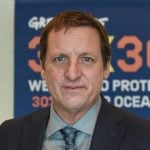This month we’re headed to a special place in the center of the Bermuda Triangle called the Sargasso Sea. It has some of the clearest ocean water on the planet and supports a spectacular array of life – much of it found nowhere else on Earth.
Unfortunately, today the Sargasso has a big problem, and that problem is plastic. Just like the Great Pacific Garbage Patch, the Sargasso sits inside a gyre. This means it’s surrounded by ocean currents – like the Gulf Stream – moving in a circle that pushes things inward. Think of it like the center of a whirlpool. This whirlpool is great for keeping Sargassum seaweed inside, which act as a nursery for baby fish and sea turtles, giving ocean wildlife a jump start.
But it also pushes and keeps plastics inside, and this is a major problem for the same wildlife. Turtles and whales choke on it and fish consume it, passing plastic toxins down the food web and back to people who eat seafood.

A white plastic lead is seen floating among Sargassum seaweed.
Plastics are killing our oceans! You’ve probably heard that from us a million times, right? But what might be new to you is that we’re not only working on solutions to address the plastic crisis on land, we’re also working to help the ocean cope with the crisis. The solution we’re proposing is to create ocean sanctuaries. These are special places, like national parks, that are set aside to protect wildlife and allow ecosystems to recover and later thrive.
We’re embarking on the expedition of a lifetime to make our case for these sanctuaries to the United Nations.

Credit: Marine Geospatial Ecology Lab, Duke University
We’re setting sail for the Sargasso Sea on the Greenpeace ship Esperanza, as part of our Pole to Pole expedition, in order to document the impact of plastics on this ecosystem. We’re going to gather scientific evidence to support why the Sargasso Sea is so special that it should be protected under a new Global Ocean Treaty currently under consideration at the United Nations. We think the Sargasso should be one of the first ocean sanctuaries created under this new treaty – particularly because of the impact that plastics are having here.
But how does this work? Sanctuaries and treaties don’t stop ocean currents from carrying plastic…
Well, have you ever had the flu? I have. The worst thing you can do when you’re sick is to do things that further stress your system out. You wouldn’t do anything that makes you sicker. You need rest.
The environment works the same way. When it’s under stress from things like plastic pollution or the climate breakdown, the best thing to do is to protect it from other stress; things like overfishing, heavy vessel traffic and deep sea mining.

The Greenpeace ship Esperanza on transit to the Azores as part of the Pole to Pole ship tour in 2019.
If we can keep those things under control by creating a sanctuary, the Sargasso’s “immune system” can better deal with its flu: ocean plastics. At least long enough for us to hold big corporations accountable and put an end to the reckless use of single use plastics.


